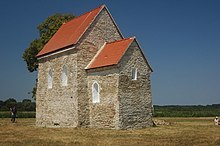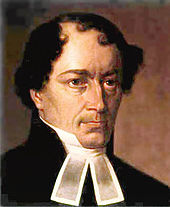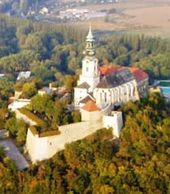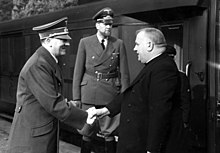Religions in Slovakia


The religions in Slovakia are primarily the Roman Catholic Church and other Christian churches and communities.
present
The largest church is the Roman Catholic Church , which in 2011 made up 62% of the population. There is also the Greek Catholic Church , especially in the northeast among the Ruthenians , the Evangelical Church of the Augsburg Confession (Lutheran), the Reformed Church , the Orthodox Church , as well as the Old Catholic Church , the New Hussite Church , Baptists , Methodists , Jehovah's Witnesses and others Communities. To Muslims , Jews and Buddhists each include a few thousand people. A total of 24% of the population is without religion or without information.
statistics
| Population of Slovakia by religion | |||||||||
| 2011 census | 2001 census | 1991 census | |||||||
|---|---|---|---|---|---|---|---|---|---|
| religion | number | % | number | % | number | % | |||
| Roman Catholic Church in Slovakia | 3,347,277 | 62.0 | 3,708,120 | 68.9 | 3,187,120 | 60.4 | |||
| Evangelical Church of the Augsburg Confession in Slovakia | 316.250 | 5.9 | 372.858 | 6.9 | 326.397 | 6.2 | |||
| Greek Catholic Church in Slovakia | 206,871 | 3.8 | 219.831 | 4.1 | 178,733 | 3.4 | |||
| reformed Church | 98,797 | 1.8 | 109,735 | 2.0 | 82,545 | 1.6 | |||
| Orthodox Church of the Czech Lands and Slovakia | 49.133 | 0.9 | 50,363 | 0.9 | 34,376 | 0.7 | |||
| Jehovah's Witnesses | 17,222 | 0.3 | 20,630 | 0.4 | 10,501 | 0.2 | |||
| Methodist Church | 10,328 | 0.2 | 7,347 | 0.1 | 4,359 | 0.1 | |||
| Kresťanské zbory (Christian communities in Slovakia) | 7,720 | 0.1 | 6,519 | 0.1 | 700 | 0.0 | |||
| Apostolic Church | 5,831 | 0.1 | 3,905 | 0.1 | 1,116 | 0.0 | |||
| Baptists | 3,486 | 0.1 | 3,562 | 0.1 | 2,465 | 0.0 | |||
| Brethren Movement | 3,396 | 0.1 | 3,217 | 0.1 | 1,867 | 0.0 | |||
| Seventh-day Adventists | 2,915 | 0.1 | 3,429 | 0.1 | 1,721 | 0.0 | |||
| Jews in Slovakia | 1999 | 0.0 | 2,310 | 0.0 | 912 | 0.0 | |||
| Czechoslovak Hussite Church | 1,782 | 0.0 | 1,696 | 0.0 | 625 | 0.0 | |||
| Old Catholic Church of Slovakia | 1,687 | 0.0 | 1,733 | 0.0 | 882 | 0.0 | |||
| Bahai | 1,065 | 0.0 | n / A | n / A | n / A | n / A | |||
| Church of Jesus Christ of Latter-day Saints | 972 | 0.0 | 58 | 0.0 | 91 | 0.0 | |||
| New Apostolic Church | 166 | 0.0 | 22nd | 0.0 | 188 | 0.0 | |||
| Other religious communities | 23,340 | 0.4 | 6.214 | 0.1 | 6.094 | 0.1 | |||
| Without religion | 725.362 | 13.4 | 697,308 | 13.0 | 515,551 | 9.8 | |||
| No information | 571,437 | 10.6 | |||||||
| total | 5,397,036 | 100 | 5,379,455 | 100 | 5,274,335 | 100 | |||
history
Early history


The oldest religions were traditional cults of the local population. With the Roman occupation since the 2nd / 3rd In the 19th century, some Christians probably also served as soldiers and colonists in what is now Slovakia. In the 9th century there were mission attempts by the Bavarian diocese of Passau . Around 828/832 the first church is said to have been founded in the castle of Prince Pribina in Nitra . The activities of the Byzantine Orthodox monks Cyril and Methodius in Great Moravia was made more difficult in the Slovak territory, the first Catholic bishop Wiching for Nitra came from Bavaria.
In the independent Kingdom of Hungary
In the early 11th century, the saints Svorad and Benedict are said to have lived in the monastery there on Mount Zobor . During this time the area was incorporated into the diocesan organization of the Hungarian state. In the 12th century a diocese was again established in Nitra for what is now Slovakia. In the following centuries numerous monasteries and churches were built. There were also Jewish communities in some cities. The theological influence of the Hussites from neighboring Bohemia probably remained small in the 15th century, as they came to the country mainly with raids and destruction.
Under the Habsburgs
After the Turkish invasion of Hungary, the seat of the Archdiocese of Esztergom moved to Trnava in the unoccupied Slovakia ( Upper Hungary) in 1543 . Since 1563, the Hungarian kings have been crowned in St. Martin's Cathedral in Pressburg . Especially in the areas of the Spiš populated by Germans, many Protestant Lutheran congregations emerged in many towns and villages during this period. In 1610 they were agreed at the Synod of Žilina . Due to a sometimes quite brutal Counter-Reformation ( blood court of Eperjes ), however, Catholicism prevailed again as the predominant denomination in the following decades.
In 1756 the first Bible in the Slovak language was created by Camaldolese monks. Catholic and Protestant clergy played a leading role in the national movement of the Slovaks from around 1780. In 1787 , the Catholic priest Anton Bernolák created the first orthography and grammar for the Slovak language. The Lutheran pastors and writers Ján Kollár , Ján Chalupka , Michal Miloslav Hodža and Jozef Miloslav Hurban were leading figures, also in the Slovak uprising of 1848/49.
In Czechoslovakia and Slovakia
In the Slovak national parties since 1913, clergymen were mostly their chairmen, for example Andrej Hlinka in the People's Party he founded and Martin Rázus in the Protestant National Party . In 1939, the former priest Josef Tiso also became the first state president of independent Slovakia , a vassal state of the Nazi state . Most of the Jews living in the country were murdered by 1945.
All religions in Czechoslovakia have been restricted since 1945, and religious freedom has been back in 1989. In 2016, a law was passed that raised the requirements for new religious communities for equal official recognition from 20,000 members with a permanent right of residence in the country to 50,000 people. Critics see this as the intention to make such recognition impossible for Islam.
Web links
Individual evidence
- ↑ On Protestantism in Slovakia most recently Karl W. Schwarz: The Protestantism in Slovakia. A bridge between languages, peoples and cultures. In: Ulrich A. Wien, Mihai D. Grigori (Ed.): Export good Reformation. Vandenhoeck & Rupprecht, Göttingen 2017. pp. 425-442
- ↑ Statistical Office of Slovakia ( PDF )
- ↑ Table 14 Statistical Office of the Slovak Republic (PDF)
- ↑ Archaeological monuments in Nitra (PDF)
- ↑ 11 kings and eight queens from 1563 to 1830 Uhorskí králi a královné korunované v Bratislave
- ^ On the Reformation in Slovakia, most recently Karl W. Schwarz: The Reformation in the area of today's Slovakia. In: Martin Zückler, Michal Schwarc, Jörg Meier (Eds.): Migration - Center and Periphery - Cultural Diversity. New approaches to the history of the Germans in Slovakia. Leipzig 2016. pp. 242–261.
- ^ Sabine Witt: Nationalist intellectuals in Slovakia 1918-1945. Walter de Gruyter, Berlin / Munich / Boston 2015. pp. 55-67
- ↑ Slovakia tightens religious law HDP, February 6, 2017



